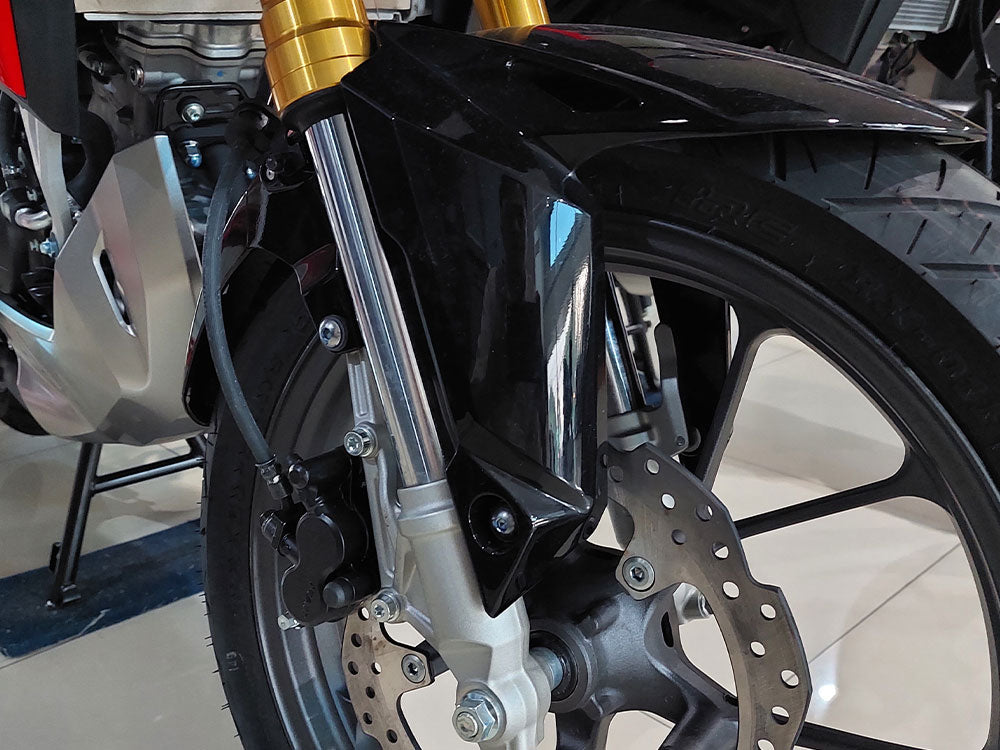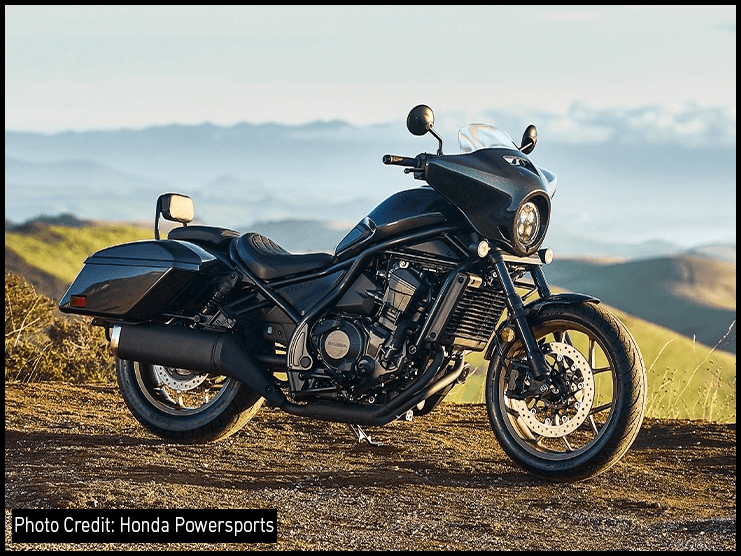Table of Content
The suspension is not on the priority list for most riders as it is thought of as secondary equipment. Little do they know that suspensions, particularly the front fork, have the most crucial role to play when it comes to handling, steering, maneuverability, ride quality, and comfort. The rear suspension has a relatively less role to play than the front forks as it only assures the rider stays comfortable and the road bumps and imperfections do not cause too much distress to the rider’s back. Meanwhile, the front fork is one of the active-most motorcycle parts during the ride and it goes through the most stress in tough riding conditions.
For years, the motorcycling world relied on conventional telescopic forks for steering and handling. However, as motorcycling got more advanced and riders started taking on adventurous and off-road challenges, the suspensions’ roles became wider on motorcycles. To combat challenges and make motorcycling more versatile and performance-oriented, engineers came to know that inverting the front fork can exhibit several advantages, including better handling, better stability, improved rigidity, and it can also withstand harsh braking.
An inverted front fork, also known as an upside-down fork or in short, a USD fork has been in use since the early 1980s and has become a favorite choice of most manufacturers. Continue reading this article to learn everything about upside-down forks, their comparison with the conventional telescopic fork, and their advantages and disadvantages.
1. What Is The Difference Between an Upright and an Inverted Fork?

If you are unsure about the telescopic and upside-down forks and the differences between them, you are at the right place to get your concept clear. Both these forks are technically the same and there is no such advanced technology incorporated in the upside-down forks.
The upside-down fork is simply the right-side-up fork, with only the difference in its orientation. For a simple definition, if you reverse the orientation of a conventional right-side-up fork, it becomes an upside-down fork with a few differences.
1.1 Right Side Up Fork
The right-side-up fork, also known as the conventional telescopic fork, has the thicker portion (the female or slider section) attached to the front wheel, i.e., is mounted downward. Meanwhile, the stanchion (thinner or male section) is attached to the triple clamp/steering head.
1.2 Upside Down Fork
The inverted or upside-down fork is opposite to the conventional telescopic fork. The USD fork features the thicker slider section attached to the triple clamp while the thinner part/chrome section is connected to the front wheel.

The “A” in the above image represents the “Sliding Area” which is greater in the inverted/upside-down forks than the conventional telescopic forks.
1.3 Right Side Up Vs Upside Down Forks Comparison
| Right Side Up Vs Upside Down Forks Comparison | |
|---|---|
| Right Side Up Fork | Upside Down Forks |
| The thicker female portion is on the lower side | The thicker female portion is on the upper side |
| The thinner section/stanchion is on the upper side | The thinner section/stanchion is on the lower side |
| Less rigid | Highly rigid |
| Less stiffer | Stiffer |
| Relatively less strength | More strength |
| Comparatively less appealing | Aesthetically appealing |
| Found usually in road bikes | Better for performance-oriented motorcycles |
| Relatively low damping rates | Offers high damping rates |
| Contains average internal parts | Contains high-quality internal components |
| Less complex | More complex |
| Easy to work on | Difficult to work on |
| Very less likely to drip oil in the brake components in case of fork oil leakage | Highly likely to drip oil in the brake components in case of fork oil leakage |
2. Upside Down Fork: Advantages and Disadvantages
For those motorcycle enthusiasts and riders who think changing the orientation of the front fork doesn’t cause any major difference in the motorbike’s performance, it does. There are numerous benefits you can avail yourself if your motorcycle has an upside-down fork.
Meanwhile, there are also a few drawbacks that you must be familiar with to avoid any issues. Let’s discuss the advantages and disadvantages of the upside-down fork on a motorcycle.
2.1 What Are the Benefits of an Upside-Down Fork?
Rigidity
An upside-down fork is more rigid than its conventional counterpart. To understand this, we will need to go deeper into the functioning and how the force functions on it while steering.
The Front fork together with the handlebars, triple clamp, and front wheel acts as a lever, deciding the handling and steering characteristics of a motorcycle. As you move the handlebars to take a turn, there is a braking stress and steering force centered at the contact patch of the front tire where it meets the ground.
However, the bending and torsional forces are majorly acting at the point where the front fork meets the triple clamp. If the tube of the front fork has a large diameter from where it connects to the triple clamp as in the case of an upside-down fork, it will provide more rigidity to the front suspension.
Bigger Diameter
The upside-down fork has a large-diameter tube from where it connects to the triple clamp, making it more rigid than the conventional right-side up telescopic fork.
More Contact Area
In the upside-down fork installed on motorcycles, the contact area between the slider (female) and stanchion section is greater than the conventional upright fork. It means that in the case of an upside-down fork, more support and rigidity are provided to the stanchion to bear more torsional load and bending forces.
Less Likely to Flex
The upside-down fork is less likely to bend thanks to the presence of the bigger female/slider portion which is the larger diameter tube. As the strength and rigidity of both the female portion and stanchion add up effectively in the upside-down fork, they are less likely to flex and get damaged even in harsh riding conditions.
Adjustability
The upside-down fork is a complex and advanced piece of equipment and is usually built with varying adjustability options to transform the way the front suspension feels while riding. Most of the advanced upside-down forks installed on performance-oriented motorbikes are fully adjustable to improve and customize your riding experience that suit your style.
Better Damping Rates
The upside-down forks, even the non-adjustable ones, offer better damping rates than their conventional counterparts. Better damping rates mean that the upside-down fork tends to be more comfortable, and stable, and ensures better-handling characteristics in most scenarios.
When a motorcycle front fork is said to have a better damping ratio, it means the fork behaves in a highly refined way when you maneuver over an uneven surface. The USD front fork absorbs vibration and shocks much more effectively while riding to translate and minimize the impact on the rider.
The sliding movement of the front fork is effectively controlled in the case of the USD fork as it compresses and rebounds slowly regardless of the bounce and uneven terrain encountered during the ride. Due to having better damping rates, the upside-down fork makes the ride experience quite smoother.
More Stiffness
The upside-down fork installed on a motorcycle offers more stiffness. You may be wondering how a stiffer front suspension is more beneficial compared to the softer conventional telescopic forks. The thing is that a stiffer suspension enables a motorcycle to not respond aggressively in terms of compression and rebounding when encountering a rough or uneven patch.
In addition, a stiffer suspension also allows motorcycles to be more stable while turning corners. You can comfortably handle them in different riding conditions.
Looks Appealing
The upside-down forks are more trendy and beefier than the conventional telescopic forks, adding more to the aesthetic appeal of a motorcycle.
2.2 What Are the Disadvantages of Upside-Down Forks?
Risk of Oil Spillage on the Front Brake Components
In case the front fork seal fails to hold the fork oil in place, the oil can leak out of the fork which is likely to happen as fork seals wear out over time. However, in the case of an upside-down fork, if the oil seal fails, it will cause the oil to leak directly into the front brake components as they are close. The worst factor here is the gravity due to which the oil leakage in the upside down fork is more dangerous as it can potentially damage the front brake.
Meanwhile, in the case of a conventional right-side-up fork, the oil spillage is less if the fork seal fails and the oil is mostly stuck to the stanchion (chrome part). Even if the oil leakage makes its way to the fork, it does not reach the brake components as it easily drips down the slider.
For such reasons, the fork seals of the upside-down fork are made more durable so they can last longer. However, it is still advised to take good care of your forks, especially the sliding surfaces, and clean them regularly to make sure there remains no dust and debris on the fork legs.
Complicated
The upside-down fork is comparatively more complicated than the conventional telescopic fork. It involves multiple parts and is difficult to manufacture compared to the conventional telescopic fork.
Expensive
The upside-down fork is built using high-quality premium parts and is difficult to make, increasing the cost of manufacture. Due to being premium equipment, motorcycles that are equipped with the upside-down fork are expensive.
Difficult to Work on
Compared to the conventional upright forks, the upside-down forks are less simple in terms of their design and build which makes them difficult to work on. They are also less easy to maintain.
Feels Similar to the Telescopic Fork in Terms of Street-Based Operation
If your riding experience is limited to street-based operation, you will not find any difference between a conventional telescopic fork and an upside-down fork. The difference is only evident as soon as you hit a track or go canyon carving on your motorcycle equipped with a USD front fork.
Less Comfortable
Upside-down forks are generally considered less comfortable than their conventional counterparts. Why? because they are stiffer and compress and rebound at a slower pace. On the contrary, conventional telescopic forks are softer and they squeeze and rebound at a much quicker pace than upside-down forks. The difference is highly evident as soon as you hit a pothole or an obstacle. A softer conventional upright fork feels more comfortable for rides that involve bumps and imperfections.
3. Why Are Dirt Bike Forks Upside Down?
Considering the above section, one may think that conventional upright forks are more suitable for dirt riding. However, it may be surprising for most of you but the upside-down forks are the preferred choice for dirt bikes. There are numerous useful qualities of upside-down forks that make them a perfect fit for dirt riding, including high rigidity, strength, stability, superior stress handling, stiffness, adjustability, better damping rates, stronger tubes, and the ability to withstand harsh conditions and torsional loads. For such reasons, the upside-down forks are considered superior for both road and motocross racing.
4. Recap: Pros and Cons of Upside-Down Forks
| Pros and Cons of Upside-Down Forks | |
|---|---|
| Pros | Cons |
| Superior rigidity | Risk of fork oil leakage |
| High strength | The fork oil can leak directly into the brake components which can be risky |
| Ensures superior cornering performance | Difficult to maintain |
| Can withstand stress handling | Complicated build |
| Ensures stability | Costlier to manufacture |
| Highly suitable for performance-oriented motorbikes | Expensive |
| Preferred choice for dirt riding | Less comfortable than conventional telescopic forks in certain riding conditions |
| Better steering capability | |
| Ensures smooth riding experience | |
| Offers better damping rates | |
| Less likely to bend | |
| More advanced | |
| Aesthetically appealing | |
| Beefier look | |
| Offers adjustability | |
| Provides better installation of braking components | |
5. Why Are Inverted Forks Better?
Inverted or upside-down forks are a more premium choice to be installed on motorcycles compared to conventional telescopic forks because of several useful advantages they offer. The inverted front fork provides a motorcycle with the most crucial performance characteristics, including improved stability, handling, steering, rigidity, and strength. These are the most basic yet primary benefits you can achieve from an upside-down fork on a motorcycle.
The disadvantages of upside-down forks are a few compared to the advantages which is why they are a highly preferred equipment to be installed on a motorcycle and are found on most premium performance-oriented bikes.
Upside-down forks are expensive, difficult to work on, and less comfortable for certain riding scenarios. Besides these cons, the one major issue with the inverted forks is gravity. The fork seal faces downward in an upside-down fork, resulting in excessive oil leakage when the seal fails. The leaked oil is more likely to enter the braking system and components, causing the risk of brake failures. Make sure to regularly clean and maintain the upside-down front fork installed on your motorbike and don’t let dirt and debris settle on the stanchion.
6. Parts for Improved Ride Quality and Experience
On top of an upside-down fork, several essential add-ons can improve the ride quality and comfort of your bike. Visit the Viking Bags ’ online store to find the best-suited parts for your specific make and model. The aftermarket parts available at Viking Bags include sissy bars , backrests , fairings , handlebars , new seats , and crash bars .
At Viking Bags, you can also find a perfect solution to improve the storage capacity of your bike for an improved touring experience. There is a wide variety of luggage bags available to choose from, including saddlebags , tour packs , sissy bar bags , tank bags , and backpacks .













Leave a comment
All comments are moderated before being published.
This site is protected by hCaptcha and the hCaptcha Privacy Policy and Terms of Service apply.